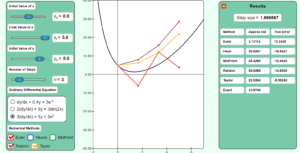Description: This simulation shows how Runge-Kutta 2nd order method works to solve ordinary differential equations of the form dy/dx=f(x,y), y(x0)=y0.
 Keywords: Ordinary differential equation, numerical methods, Runge-Kutta 2nd order method, Taylor series, Euler’s method.
Keywords: Ordinary differential equation, numerical methods, Runge-Kutta 2nd order method, Taylor series, Euler’s method.
Learning Objectives: After successful completion of running the simulation with proper questions asked by the instructor, the student would be able to 1) note how the Runge-Kutta 2nd order methods of solving ordinary differential equations work 2) study the effect of step size on the convergence of the methods 3) compare results with exact, Euler’s method, and directly using the first three terms of the Taylor series.
Full Resources: The full resources for the topic include textbook content, PowerPoint presentations, multiple-choice tests, audiovisual lectures, and application examples.
Software Requirements: Latest versions of Safari, Microsoft Edge, Firefox, Google Chrome.
Credits: Design Team: Autar Kaw and Mayank Pandey. Software development: Mayank Pandey and Autar Kaw.
We acknowledge the immense help of the PhetSims Google group, third party libraries: almond-0.2.9.js, easing-equations-r12,FileSaver-b8054a2.js, fontawesome-webfont-3.0.2.svg, jama-1.0.2, jquery-2.1.0.js, lodash-2.4.1.js, pegjs-0.7.0.js, seedrandom-2.4.2.js, text-2.0.12.js, Tween-r12.js
Acknowledgments: This material is based upon work supported partially by the National Science Foundation under Grant Number 2013271. Any opinions, findings, and conclusions, or recommendations expressed in this material are those of the author and do not necessarily reflect the views of the National Science Foundation.
All Simulations: Here is the link for all the simulations developed.
